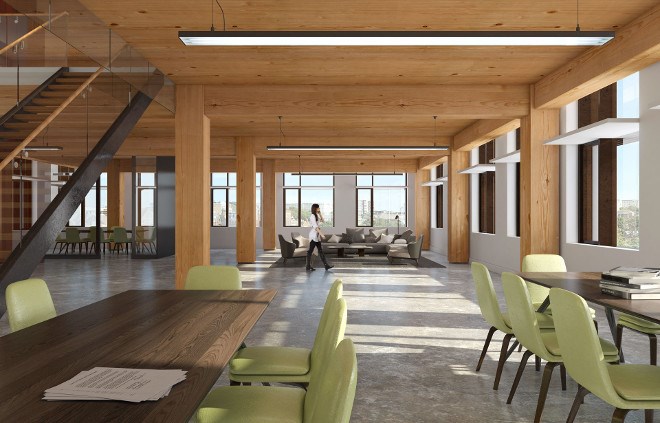Northern Ontario wood will feed the province’s first cross-laminated timber (CLT) plant in southwestern Ontario.
Patrick Chouinard, a co-founder of Element5, the operators of a proposed $32-million facility in St. Thomas, said the fibre sourced for their operation will come from the White River area.
He said siting a CLT plant in Northern Ontario was their first option when they were deciding where the building was going to go. But after crunching the numbers, Chouinard said it made economic sense for the plant to be close to their customers.
“Because of the cost of transportation, it was decided that the plant really had to be in southern Ontario where the majority of our opportunities are.”
The Ontario government announced July 23 that it’s investing close to $5 million in the company’s automated plant and the 60 manufacturing jobs. That’s tacked on to a $2-million grant they were awarded last February by CRIBE (Centre for Research and Innovation in the Bio-economy), a Thunder Bay-based forestry research group.
Element5 is a Toronto and Montreal-based design, engineering and fabrication group specializing in mass timber buildings.
Their main product, CLT, is a wood panel made from gluing sawn lumber together. It’s used in ceilings, walls and roof structures.
The company is positioning itself to be on the forefront of the North American wood high-rise construction movement.
Their target markets are to serve Eastern Canada and the U.S. with a range of innovative and value-added building products that are rapidly gaining popularity for use in wood-framed buildings as building codes permit higher structures.
The St. Thomas location is roughly an hour-and-half drive from the Windsor-Detroit border and about two hours from the bridge to Buffalo.
Chouinard’s firm also operates a CLT plant in Ripon, Que. that is being expanded with a new building and equipment toward producing 10,000 cubic metres of CLT and Glulam (glue laminated timber).
“What we sell are pre-fabricated buildings,” said Chouinard. “At the moment we’re doing everything from tiny homes through to Hines T3 buildings.”
Their St. Thomas plant will use mostly 2-by-6 SPF lumber coming in largely from mills near the north shore of Lake Superior.
Element5 is an extension of Tembec founder Frank Dottori’s business interests.
Through his company, WRC Timber, Dottori purchased a 50 per cent stake in Element5 last year.
The firm’s other owners are Chouinard and his business partners, Fred Dinizo and Carl Galli.
Dottori is also the chair of WRC Timber, the parent company of sawmills in White River and Hornepayne. He stepped down as president of WRC last January to focus on working with the Element5 to site a CLT plant in Ontario.
With lumber prices dropping precipitously in 2018 and his mills heavily impacted by U.S. softwood lumber tariffs, Dottori, who was not available for comment, said last winter that CLT was exactly the downstream fix he was looking for.
He vowed the Ontario site “would probably be the biggest industrial fabricator of CLT in North America.”
Ground hasn’t been broken yet in St. Thomas but Chouinard said their plans are to be in operation by December 2020.
The finished product will be CLT panels; Glulam, used for columns and beams; and also nailed laminated timber (NLT), used for floors and roofs.
Production capacity at St. Thomas will be 45,000 cubic metres each year, but Chouinard said the plant will definitely be scalable. His company bought 20 acres in the north end of the city with the option of buying an additional 20.
“Assuming things go well, we’ll be expanding into the lot next door.”
A rail spur runs onto the property and with Highway 401 not far away, they have the flexibility of receiving and shipping product by both rail and truck.
Chouinard said besides having ready access to the whole central and eastern seaboard of the U.S., their other advantage is the currency exchange. Even with CLT plants coming online in the U.S., their American customers would still enjoy a 30 per cent discount.
“We don’t anticipate that changing for the foreseeable future."
In high-rise timber construction, British Columbia is pushing the limits with Brock Commons, a hybrid wood and concrete building now standing at 18 storeys. Changes to the national building code are expected to allow for 12-storey structures by next year.
“The higher we can go, the higher the opportunity for us to be able to sell mass timber,” said Chouinard.
“At the moment, the Ontario Building Code allows us to go to six storeys but as that goes up, it increases the potential opportunities for us. It’s certainly a welcome change.”
In Ontario, Chouinard said the next step is likely 12 storeys, which would mirror what’s happening in Quebec.
In forecasting the use of CLT over the next three to five years, “demand is going to outstrip supply, I’m sure about that,” said Chouinard.
“We’re expecting to $35 million in sales, per year, over the next couple of years, assuming we’re at capacity.”
Chouinard called the company’s news a “win-win-win” situation for the province, the forestry industry and the environment.
“We’ve had to make a significant effort and investment in order to guarantee the use of Ontario wood but it’s a great opportunity for the Northern forestry industry. It gives Canada a leadership role in this emerging and innovative industry, it’s a cheaper and faster way to build, and creates much healthier environments for (building) occupants, and that’s fantastic for the environment. There’s no negative in this whatsoever.”




